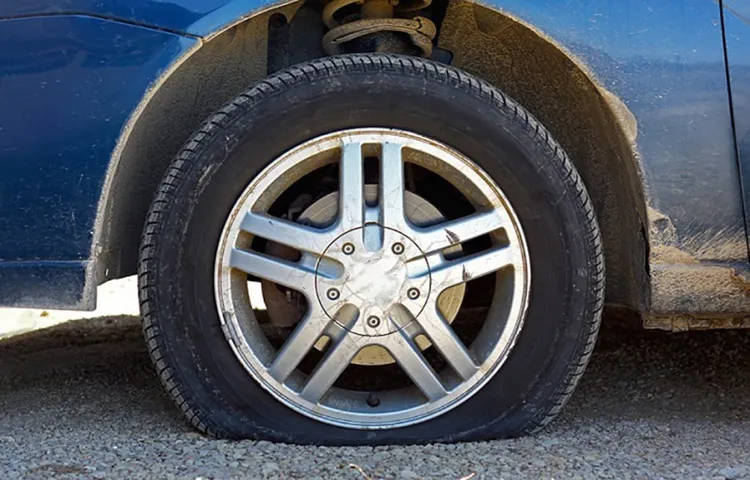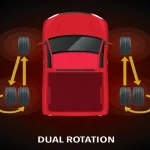Picture this: you’re driving down the highway, enjoying the scenery and the open road when suddenly – BAM! Your car starts to shake, and you realize you have a flat tire. Panic sets in as you try to navigate your way to the side of the road, all while trying to avoid getting hit by passing cars. Dealing with a flat tire on the highway can be a nightmare scenario, but it doesn’t have to be.
In this blog post, we’ll explore some tips and tricks for staying safe while changing a tire on the side of a busy highway, as well as providing some helpful tidbits to make the process as smooth as possible. Whether you’re a seasoned driver or a newbie on the road, this post will help you feel more confident and prepared in the event of a flat tire emergency. So buckle up and let’s dive in!
Table of Contents
Assess the Situation
If you find yourself stranded on the highway with a flat tire, the first thing you should do is assess the situation. Pull over to the side of the road and make sure that you are out of harm’s way. Turn on your hazard lights to alert other drivers of your presence and put on your reflective vest if you have one.
Once you have ensured your safety, take a look at your tire and determine the severity of the damage. If the tire is completely flat or has a large puncture, you will need to change it as soon as possible. On the other hand, if it’s just slightly deflated, you may be able to patch it temporarily and drive to the nearest service station.
The key is to stay calm and evaluate the situation carefully before taking any action. Remember, safety should always be your top priority on the highway.
Check for Safety
When faced with any situation that requires you to assess the potential dangers for you and others around you, it’s important to approach it calmly and methodically. Check for safety by first evaluating the scene for any obvious threats or hazards that could cause harm, such as fires, falling debris, or dangerous chemicals. If you can safely do so, get yourself and others to a safe distance from the area until it’s deemed safe by officials.
It’s important to also take into consideration any potential hidden dangers, such as gas leaks or electrical wires, that could cause harm. Assessing the situation thoroughly before taking any action can help prevent further harm or injuries. Remember, when it comes to safety, it’s always better to err on the side of caution.

Check the Tire
When you’re on the road, the most crucial thing is safety. And when it comes to safety, checking your tires is one of the most critical steps you need to take. Assessing the situation means checking for any visible damage to the tire, such as cuts, bulges, or punctures.
You also need to ensure that the tire pressure is at the recommended level. If the pressure is low, it can affect the handling and fuel efficiency of your vehicle. To check the tire pressure, use a gauge or visit a gas station that provides tire pressure monitoring services.
Remember, a little caution goes a long way in ensuring your safety on the road. Always make sure to check your tires before you hit the road.
Change the Tire
Driving on the highway and experiencing a flat tire can be a terrifying experience, but it’s essential to remain calm and be prepared to handle the situation. Your first step should be to pull over to a safe spot away from traffic. Turn on your hazard lights and exit your vehicle.
Locate your spare tire, jack, and lug wrench, which are usually found in the trunk. Begin by loosening the lug nuts on the flat tire while the car is still on the ground. Then, using the jack, lift the vehicle off the ground and remove the lug nuts completely.
Take off the flat tire and place the spare tire onto the car’s hub. Replace the lug nuts and tighten them snugly with the wrench. Lower the car to the ground using the jack, then fully tighten the lug nuts in a star pattern.
Once you’re done, ensure the spare tire is properly inflated to the recommended PSI for your vehicle. Remember to take your flat tire and tools with you, and get your tire repaired or replaced as soon as possible. With these simple steps and a bit of knowledge, you’ll be back on the road in no time.
Locate the Spare Tire and Tools
When it comes to changing a tire on your vehicle, it’s essential to know where the spare tire and tools are located. Usually, the spare tire and the tools come located in the trunk of your vehicle, but it’s always a good idea to double-check before you hit the road. Once you have located the spare tire and the tools, it’s essential to take them out of the trunk and place them near the car’s tire that needs to be changed.
Ensure that you have a jack, lug wrench, and the spare tire while changing the tire. It is essential to take the spare tire’s appropriate size, so it fits perfectly and prevents any unwanted accidents while on the road. Checking the spare tire’s conditions before using it and ensuring all the tools are in good condition is crucial.
A faulty tool could increase the time it takes to change the tires and even cause unwanted accidents. After changing the tire, it’s essential to store the flat tire safely in the trunk, so it doesn’t move around while driving. Now that you know the essential things to do and check, you’re ready to change your tire in case of any unfortunate tire damage or puncture.
Lift the Car and Remove the Flat Tire
Now that you’ve located your car’s spare tire, it’s time to get to work and change that flat. The first step is to lift the car and remove the flat tire. To lift the car, use a jack that is designed specifically for your car’s weight.
Place the jack underneath the designated lift points, which can be found in your car’s owner’s manual. Once the jack is in place, start cranking it up until the car is lifted off the ground. Make sure it’s high enough so that you can easily remove the flat tire and install the spare.
Take out the lug nuts with a wrench and keep them in a safe place. Carefully remove the flat tire and replace it with the spare. Before tightening the lug nuts, make sure the spare tire is on straight and secure.
Once everything is in place, use the wrench to tighten the lug nuts in a star pattern to ensure even tightening. Then slowly lower the car back down to the ground with the jack and remove it. Make sure to double-check the lug nuts to ensure they are tight enough.
Congratulations! You’ve successfully changed a flat tire.
Install the Spare Tire
When you have a flat tire, it’s crucial to know how to install the spare tire correctly. Firstly, make sure you park your car on a flat surface and engage the emergency brake to prevent any accidents. Then, locate your spare tire, jack, and lug wrench.
Use the lug wrench to loosen the lug nuts on the flat tire before raising the car with the jack. Remove the flat tire and replace it with the spare tire, hand-tightening the lug nuts in a star pattern before lowering the car. Finish tightening the lug nuts until they are snug using the lug wrench in the opposite star pattern.
Finally, check the tire pressure, and you are ready to hit the road again! Remember to take your flat tire to a professional service center to assess the damage and possibly repair the flat tire. Being prepared with the knowledge to change a tire can prevent significant delays and ensure your safety while driving.
Seeking Help
Having a flat tire on the highway can be a terrifying experience, but the important thing is to stay calm and find help as soon as possible. If you have a spare tire and are confident in changing it, be sure to pull over to a safe location, turn on your hazard lights, and use your jack and lug wrench to change the tire. However, if you are not comfortable changing a tire or do not have a spare, it is best to call for assistance.
Many car insurance companies offer roadside assistance as part of their coverage, so check your policy to see if you are covered. Additionally, there are several national roadside assistance companies that can help you in a pinch. Remember, it is never safe to attempt to change a tire on a busy highway, so your first priority should always be finding a safe place to wait for help to arrive.
With the right resources and assistance, you can resolve a flat tire on the highway quickly and safely.
Contact Roadside Assistance
When you find yourself stranded on the side of the road, it can be a stressful and overwhelming experience. Whether you’ve experienced a flat tire, engine trouble, or any other issue, contacting roadside assistance can help alleviate much of the anxiety and frustration. Roadside assistance providers offer a range of services, including towing, jump-starts, fuel delivery, lockout assistance, and more.
When seeking help, it’s important to remain calm and provide your location and the nature of your problem to the dispatcher. Having the contact information for your roadside assistance provider readily available can save time and reduce stress in an emergency situation. Remember, when in doubt, don’t hesitate to call for assistance to help keep you safe on the road.
Keyword: roadside assistance.
Call for a Tow Truck
Getting stuck on the side of the road is never fun, but sometimes it’s inevitable. When your car breaks down, and you’re stranded, your best option is to call for a tow truck. Seeking help from a reliable towing service can be a lifesaver, especially when you’re in an unfamiliar area and don’t know what to do.
Not only will they provide you with a safe and secure tow, but they’ll also be able to advise you on what to do next. The key is to find a reputable towing service that you can trust. With a simple Google search, you can find numerous towing companies in your area.
Before calling, make sure to read reviews from previous customers to ensure you select a service provider that is professional and experienced. By doing so, you can rest assured that you’ll receive top-notch service and get back on the road as quickly as possible.
Prevention Tips
Experiencing a flat tire on the highway can be a stressful situation, but there are a few things you can do to prevent it from happening in the first place. Ensure your tires are properly inflated and check them regularly for wear and tear. Avoid overloading your vehicle as this can put extra pressure on your tires and lead to a blowout.
It’s also important to be aware of the road conditions and avoid driving over potholes or debris. If you do find yourself with a flat tire on the highway, try to safely pull over to the side of the road as quickly as possible. Turn on your hazard lights and use your spare tire or call for roadside assistance.
Remember to never attempt to change the tire on a busy highway, as it can be dangerous. With a little prevention and quick thinking, you can avoid the inconvenience and danger of a flat tire on the highway.
Conclusion
In conclusion, when faced with a flat tire on the highway, it’s important to stay calm and follow these simple steps: pull over to a safe location, assess the damage, and either change the tire yourself or call for assistance. Remember, a flat tire may slow you down, but it doesn’t have to ruin your day. So keep calm, and carry on, because as they say, life is too short to let a popped wheel get you down!”
FAQs
What should I do if I have a flat tire on the highway?
The first step is to safely pull over to the side of the road and turn on your hazard lights. Then, assess the damage to your tire and either change it yourself if you know how, or call for roadside assistance.
Can I still drive on a flat tire?
No, driving on a flat tire can cause further damage to your car and put you in danger. It is important to pull over and address the issue as soon as possible.
Is it safe to change a tire on the side of the highway?
It is important to exercise caution when changing a tire on the highway. Make sure you are as far away from oncoming traffic as possible, and consider using safety equipment like cones or reflectors to alert other drivers.
What tools do I need to change a tire on the highway?
To change a tire, you will need a spare tire, a lug wrench, a jack, and a tire iron. Make sure to familiarize yourself with these tools and how to use them before hitting the road.
How can I prevent a flat tire on the highway?
Regularly check your tire pressure and tread wear, and avoid driving on roads with potholes or debris. Additionally, make sure to have a spare tire and the necessary tools in your car at all times.
How long does it take to change a tire?
The amount of time it takes to change a tire can vary depending on your level of experience and the tools you have. On average, it takes about 20-30 minutes to change a tire.
Do I have to replace a flat tire, or can it be patched?
Whether or not you can patch a tire depends on the location and severity of the damage. Small punctures on the tread of the tire can often be patched, while more significant damage may require a full tire replacement.


